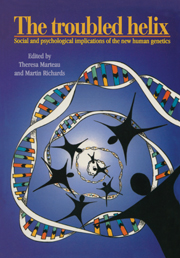Book contents
- Frontmatter
- Contents
- List of contributors
- Preface
- Preface to the paperback edition
- Acknowledgements
- Part I Personal stories
- Part II Clinical context
- 2 The new genetics: a user's guide
- 3 Decision-making in the context of genetic risk
- 4 Genetic counselling: some issues of theory and practice
- 5 Evaluating carrier testing: objectives and outcomes
- 6 Psychosocial aspects of prenatal screening and diagnosis
- 7 The genetic testing of children: a clinical perspective
- 8 Predictive genetic testing in children: paternalism or empiricism?
- Part III Social context
- Index
6 - Psychosocial aspects of prenatal screening and diagnosis
from Part II - Clinical context
Published online by Cambridge University Press: 01 June 2011
- Frontmatter
- Contents
- List of contributors
- Preface
- Preface to the paperback edition
- Acknowledgements
- Part I Personal stories
- Part II Clinical context
- 2 The new genetics: a user's guide
- 3 Decision-making in the context of genetic risk
- 4 Genetic counselling: some issues of theory and practice
- 5 Evaluating carrier testing: objectives and outcomes
- 6 Psychosocial aspects of prenatal screening and diagnosis
- 7 The genetic testing of children: a clinical perspective
- 8 Predictive genetic testing in children: paternalism or empiricism?
- Part III Social context
- Index
Summary
The antenatal clinic has been the scene of much of the routine screening carried out by the medical profession, and much of what we know about people's reaction to routine screening has been derived from this setting. At present, few of the tests offered to pregnant women owe their existence to the new genetics. However, increasingly such tests will be possible and it is expected that a major application of the new genetics will be determining the genetic status of a fetus. This may involve new techniques such as direct sampling of fetal cells from maternal blood. In the immediate future, however, it will use the same techniques for obtaining information about the fetus as are currently used in prenatal testing (e.g. amniocentesis and chorionic villus sampling), even if subsequent laboratory techniques will be different.
In this chapter we shall describe the tests commonly used in pregnancy to detect fetal abnormality, summarise what is known of their psychosocial benefits and hazards and consider likely future developments including carrier screening for recessive disorders during pregnancy (see also Chapters 3 and 5). First, however, we shall discuss the important distinction between ‘screening’ and ‘diagnosis’.
Screening versus diagnosis
Most genetic disorders are extremely rare, of the order of one in a number of thousand pregnancies, and there are a great many of them. It would not be feasible to test every pregnancy for every known disorder, even if this were thought desirable.
- Type
- Chapter
- Information
- The Troubled HelixSocial and Psychological Implications of the New Human Genetics, pp. 140 - 163Publisher: Cambridge University PressPrint publication year: 1996
- 29
- Cited by

